Table of Contents
- Editor’s Choice
- Business and Digital Transformation Statistics
- Digital Transformation Statistics by Technologies
- Digital Transformation Statistics by Management
- Digital Transformation Statistics by Spending
- Leading Agile Project Management Software
- Revenue from Digital Transformation Statistics
- Digital Disruption Statistics
- Workforce and Digital Transformation Statistics
- Technology Adoption Statistics
- Market Size Digital Transformation Statistics
- Regional Analysis
- Recent Developments
- Conclusion
- FAQ’s
Digital Transformation Statistics: Digital Transformation (DX) used to be something companies did for fun; since COVID-19 hit business operations globally, companies are viewing DX as an essential process to protect their businesses as evidenced by recent digital transformation data.
Digitization also plays a crucial role in adding value for business; evidenced by investments being made into AI systems and top business intelligence solutions by numerous firms worldwide.
If your business has yet to digitally organize itself, you are missing out. Chances are your competitors have already started to use digital marketing services and 46% of small-sized businesses currently use business intelligence (BI) software.
Additionally, connected cloud and multi-cloud solutions show how rapidly technology changes the face of business.
Editor’s Choice
- The Global Digital Transformation Market size is expected to be worth around USD 8,567.4 Billion by 2033, from USD 829.5 Billion in 2023, growing at a CAGR of 26.3% during the forecast period from 2024 to 2033.
- Currently, 65% of businesses have plans in place to improve collaboration among analytics teams, data science teams, and business units.
- Currently, 65% of companies have plans in place to improve collaboration among data science teams, analytics teams, and business divisions.
- 91% of businesses are engaging in some form of digital activity.
- Digitalization is a top goal for 87% of senior executives.
- 40% of businesses have advanced digital projects.
- Market pressure and growth possibilities motivate 51% of digital transformation attempts.
- During the outbreak, 70% of companies chose to increase or maintain their digital transformation spending.
- As a result of COVID-19, 76% of businesses expect long-term IT challenges.
- COVID-19 will have an impact on more than a third of the technology budget increases in 2021.
- 97% of IT decision-makers are pursuing digital transformation projects.
- By 2024, 25% of large corporation CIOs will be held accountable for digital business operating results, a practice known as “COO by proxy.”
- Hyper-automation, multi-experience, democratization, and human augmentation are among the top strategic technological themes that will create disruption and growth.
(Source: Forrester, Prophet, IFS, SWZD, MuleSoft)
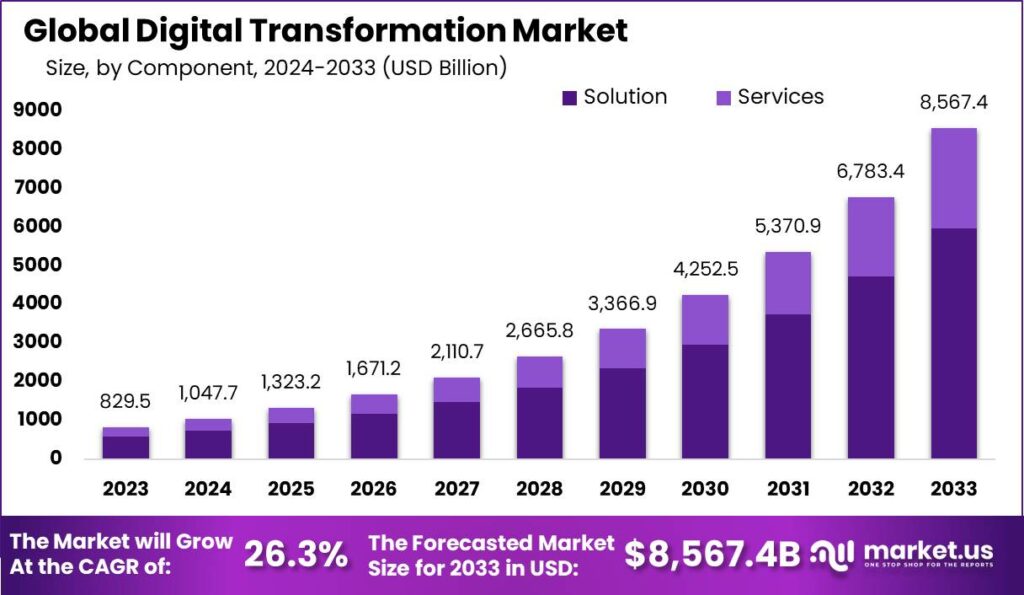
Business and Digital Transformation Statistics
Digital transformation has rapidly been adopted into modern business practices, with numerous organizations adopting digital strategies.
Not just large corporations but also smaller firms have taken part, exponentially expanding the market for digital transformation.
Take advantage of our unbeatable offer - buy now!

A variety of industries such as healthcare and financial services have participated. Adopting such strategies doesn’t guarantee instant growth for your company; oftentimes businesses reap its benefits gradually over time.
- In 2022, the Global Digital Transformation Market was estimated at 535 billion dollars and projected to reach USD 3,375 billion by 2032 – representing a compound annual growth rate of 20.8%.
- Digitally transformed businesses are projected to account for more than half of the world’s gross domestic product (GDP) by 2023 – amounting to $53.3 trillion according to IDC 2020’s estimate; by 2022 the entire global GDP may have become digitalized.
- 70% of businesses have or are in the process of creating a digital transformation plan.
- Industries believed to have seen the most benefit from digital changes are considered.
- 55% of startups have implemented digital strategies as part of their business plans.
- while the majority of conventional firms have also adopted digital-first business strategies.
- 89% of businesses plan to implement or have already implemented a digital business strategy.
- with services firms (95%), financial services (93%), and healthcare (92%) being among those most likely to adopt digital strategies.
- Three-quarters of CEOs anticipate benefitting from digital transformation efforts within three to five years.
- 21% of North American and European enterprises claim they are undertaking this transformation.
(Source: Market.Us, IMF 2020, PTC 2019, IDC 2018, Fortinet in 2018, Forrester 2018)
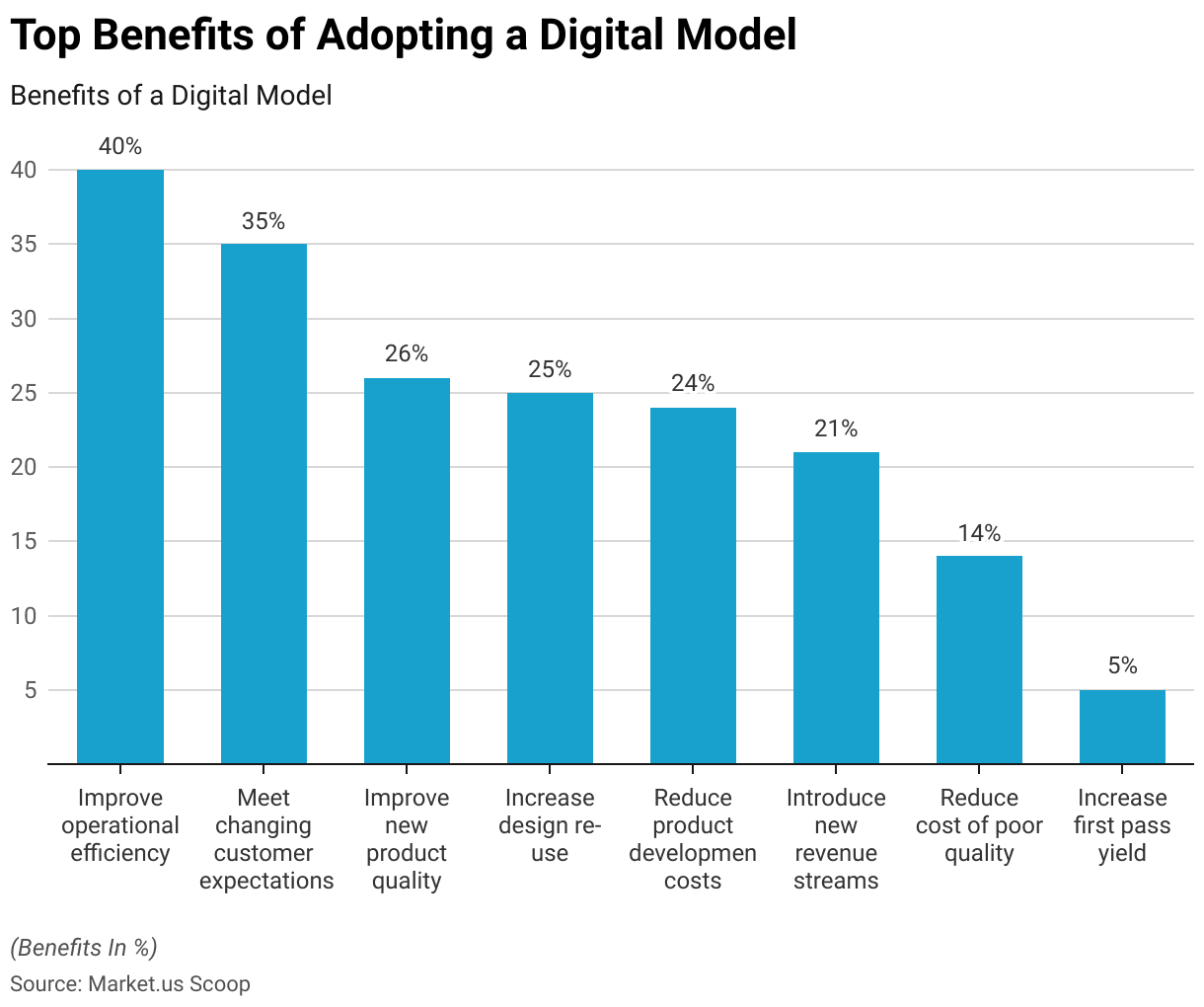
Digital Transformation Statistics by Technologies
Digital transformation refers to the practice of employing modern technology to transform existing business processes and existing services, using artificial intelligence (AI), cloud computing, and IoT technologies as means for digitization.
Businesses use these technologies for developing digital strategies – AI statistics provide evidence for this point while digital transformation technologies data provides even more details about them.
- 58% of companies with high levels of digital maturity provide digitally connected products; 17% of lower maturity firms reported the same.
- Digital technology implementation can accelerate progress toward business goals such as financial return, workforce diversity, and environmental objectives by 22%.
- 69% of high-growth companies utilize digital technology to reduce carbon emissions; 58% of lower-maturity firms also employ this strategy.
- Successful companies coping with pandemics exhibited various technological capabilities. 75% said they were able to fill tech positions during times of crisis, 67% were more adept in using technology than their peers before the crisis, and 56% pioneered experimental digital technology during crises.
- 51% of digital transformation efforts stem from growth opportunities.
- 70% of executives anticipate that IoT will play an integral part in their digital marketing strategies.
- Big data and analytics technologies were the most frequently employed (58%), followed by mobile technology (59%) APIs, as well as embeddable technologies (40%).
- Top benefits for organizations include increased operational efficiency (40%), faster times-to-market (36%), and exceeding customers’ expectations (35%).
- Merely 30% of tech companies are engaged in digital transformation initiatives for organizations.
(Source: Deloitte 2020, McKinsey 2020, Altimeter 2019, IDC 2018)

Digital Transformation Statistics by Management
Digital transformation has proved advantageous to numerous companies, leading to widespread usage of digital technology.
Unfortunately, embarking on the digital revolution does not always lead to success; indeed, 70% of efforts have failed in meeting their goals due to poor management strategies.
Tools for managing digital assets may help, yet tech managers often neglect aspects like business strategy, employees’ concerns, and customer service.
These factors all can lead to subpar results; effective management leads to positive results as evidenced in these figures.
- 29% of executives at companies with high levels of digital maturity praised digital transformation’s positive effect on innovation and growth, while 41% noted its positive contribution to marketing and sales tasks.
- 38% of executives plan to invest more in technology to gain an edge in the market.
- 70% of organizations consider their CEO’s knowledge of emerging technologies to be adequate or above average.
- Altimeter 2019 reports that 28% of Chief Information Officers and 23% of CEOs were charged with overseeing or supporting digital transformation initiatives.
- 37% of IT initiatives being implemented globally by businesses aim at improving customer satisfaction;
- 39% of CEOs ranked digital transformation as their top priority for CIOs.
- CIO 2020 reported that 67% of CIOs view revenue-generating initiatives as one of their responsibilities.
- Furthermore, 78% of Directors of IT indicated increased interactions with Directors of the Board before.
- Lack of expertise to lead digital initiatives is among the main obstacles to digital change.
(Source: Deloitte 2020, McKinsey 2020, Futurum 2018, Altimeter 2019, Flexera 2021, CIO 2020, Jabil)
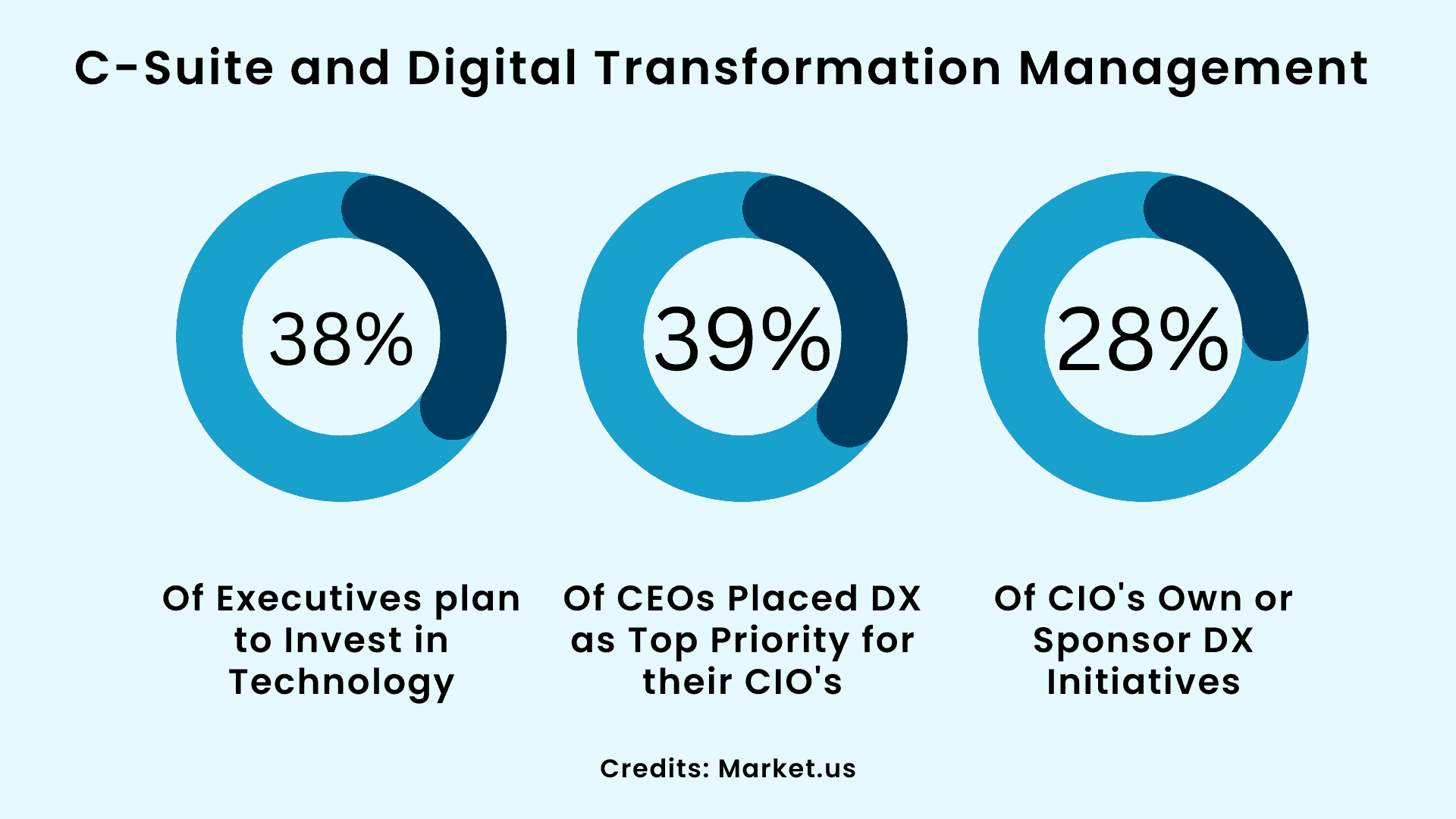
Digital Transformation Statistics by Spending
Digital transformation offers numerous advantages to companies. Financial gains outstrip all others as this is what businesses seek most out of digital transformation.
Businesses like Target, Best Buy, and Hasbro that took early advantage of the digital revolution have seen their profits and stock prices soar as early adopters of this transformation process reaped its benefits early on in its existence.
All kinds of technology providers also reaped considerable market share from digital transformation efforts; when you examine the following statistics you will see just how much companies have been investing in this endeavor.
- 40% of technology expenditure goes toward digital transformations.
- $2 trillion was the total corporate investment in digital transformations in 2019.
- 28% of companies consider it expensive.
- Tech initiatives at 54% of firms globally include digital transformation; 49% have prioritized cybersecurity.
- Global investments for digital transformation from 2020-2023 are estimated at $6.8 trillion.
- By 2023, worldwide spending on technologies and services enabling digital transformation is expected to hit $2.3 trillion.
- Investment in logistics digital transformation alone could reach $84.6 billion due to COVID-19.
- IT leaders around the globe have reported an average increase of 5% in their IT budget to combat the COVID-19 virus.
(Source: CIO 2018 2019, Altimeter 2019, Flexera 2021, IDC 2020, KPMG 2020)
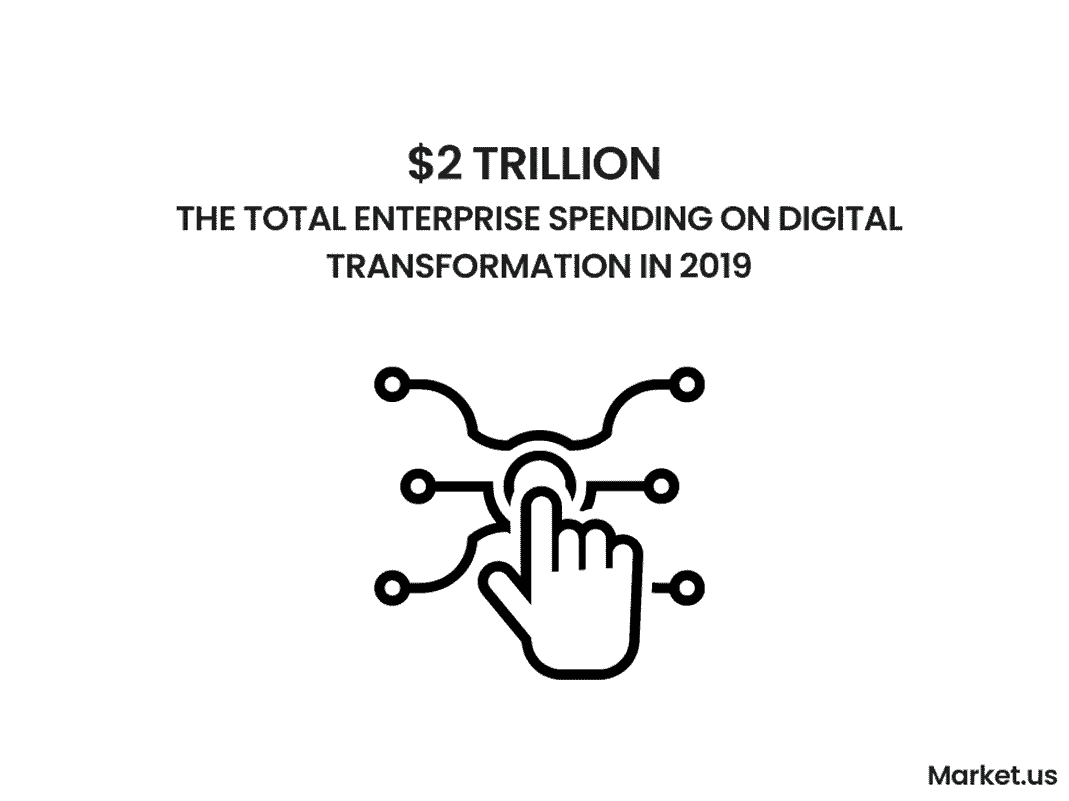
Leading Agile Project Management Software
- Monday.com is an adaptable platform, so you can customize it to meet the unique requirements of agile project management. Learn more about its features by reviewing our monday.com review.
- Wrike is an amazing tool to increase team effectiveness in both colocated and geographically dispersed teams alike. Discover more of its capabilities by reading reviews of Wrike.
- Smartsheet offers an innovative method for efficiently overseeing projects. The following review of Smartsheet gives more insight into its platform.
- Asana is an extremely popular solution for teams as it allows them to customize the interface according to their work process. Discover more of what this platform has to offer through this Asana review.
- Project Manager is an all-in-one platform, comprising scheduling, project management, collaboration tools, and collaboration solutions. Reviewing Project Manager can help familiarize you with its various features.
Revenue from Digital Transformation Statistics
Digital transformation has proven itself an essential tool in increasing corporate profits and shareholder returns while simultaneously driving high-tech B2B sales through digitization.
Businesses that rely on this form of change recognize its invaluable benefit as an asset that should not be underestimated.
Companies that were quick to adopt digital technology during COVID-19 managed to maintain or increase revenue during an economic downturn as evidenced by profits generated through digital transformation.
Companies who were quick to adopt digital technology during COVID-19 also managed to protect or increase revenue during a recession, as evidenced by profits generated from digital transformation as shown below.
- High-tech B2B firms that had transformed their customer experience processes reported cost reductions of 10-20% and revenue increases of 10-15%.
- This research also showed that digital leaders in B2B had five times faster revenue growth rates than their peers.
- 70% of marketers believe technology has far outshone rivals.
- In 2018, it was discovered that adopting digital-first strategies could increase revenue by 34%.
- Recently, high-tech B2B sales have been observed as one of the outcomes of digital transformation.
- Companies with greater levels of digital maturity reported revenue gains of 445% as opposed to 15% among companies with lesser levels.
- When revenues declined as a result of COVID-19, 44% said their focus was digital change initiatives.
(Source: McKinsey 2016/2020, IDC 2018, Deloitte 2020, Adobe 2021)
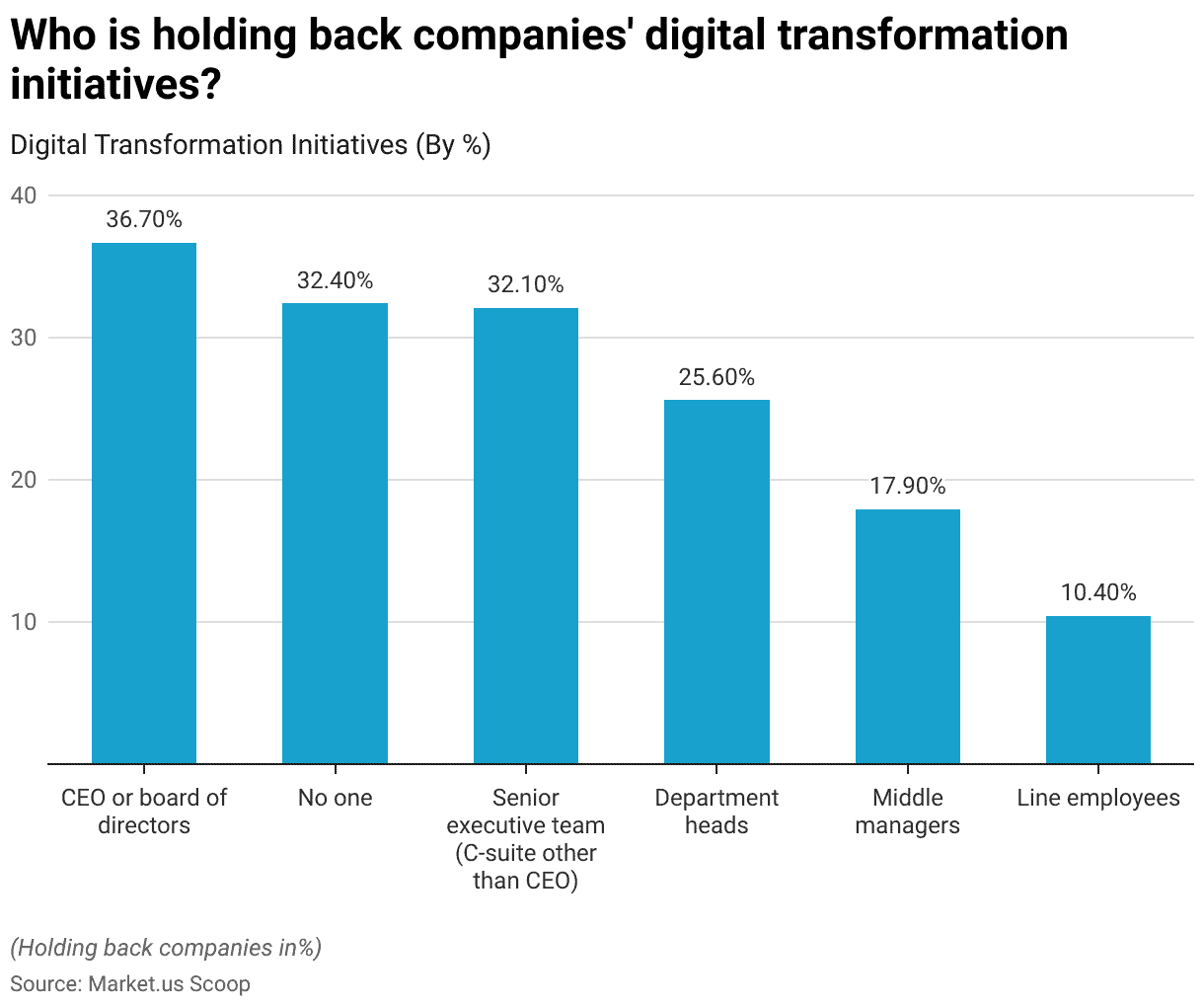
Digital Disruption Statistics
Innovative technologies are integral to the digital revolution, yet many can be complex and make it challenging for businesses to adapt.
Technology disruptions may disrupt various business sectors – and potentially create employment. Explore how disruptions have impacted companies with these statistics.
- As companies made technological advancements during this outbreak, 93% of businesses surveyed stated they needed to move toward remote working, while 62% responded that increased customer demand required them to manage online purchasing and services (and 62% saw increased migration of business assets to cloud storage).
- 54% of respondents feel confident in the likelihood that remote work arrangements implemented during the pandemic will remain.
- 40% of CEOs reported the most significant benefits of digitally transforming their businesses as being improved operational efficiency, with 36% reporting it was faster speed to market.
- 64.5% of businesses can adapt to changing technologies.
- Futurum 2018 reports that 67.8% of businesses have experienced disruptions that had either a positive or neutral effect on job creation and 37.3% reported an increase in jobs created due to technological disruption.
- 31.3% of businesses report negative effects from technology disruption on job creation, while 50.4% express optimism towards disruption.
- 20% of departments fail to keep pace with technological changes.
(Source: McKinsey 2020, Futurum 2018, PTC 2019)

Workforce and Digital Transformation Statistics
Digital transformation can have both positive and negative ramifications on employees directly, depending on their employer.
Digitization cannot take place without employee participation; digitization requires highly sought-after digital competencies that employees need to participate in.
On the flip side, digitization may negatively affect current employment markets as it creates opportunities for new corporate positions that demand specialized sets of skills – for instance, a career path toward digital project managers may diverge from the conventional roles of project management.
- 71% of CEOs cite their employees as either extremely valuable or critical to the success of their digital transformation strategies.
- Recently, 89% of IT directors of IT have reported an increasing need for advisors to help navigate emerging technologies, processes, and techniques.
- Furthermore, 90% of jobs expected in the future will require digital skills.
- 68% of executives believe collaboration between AI and humans is integral for business.
- Yet 44% of those aged 16-74 years in Europe do not possess basic digital literacy.
- At 49%, skills necessary for digital transformation as well as technology integration and implementation were listed.
- 15.7% of companies reported technology disruption was the cause of “job death”.
- 41% of remote workers experienced cybersecurity concerns when switching from traditional working arrangements to working from home.
(Source: Industry Week 2018, CIO 2020, KPMG 2020, European Commission 2017, Fujitsu 2018, Futurum 2018)
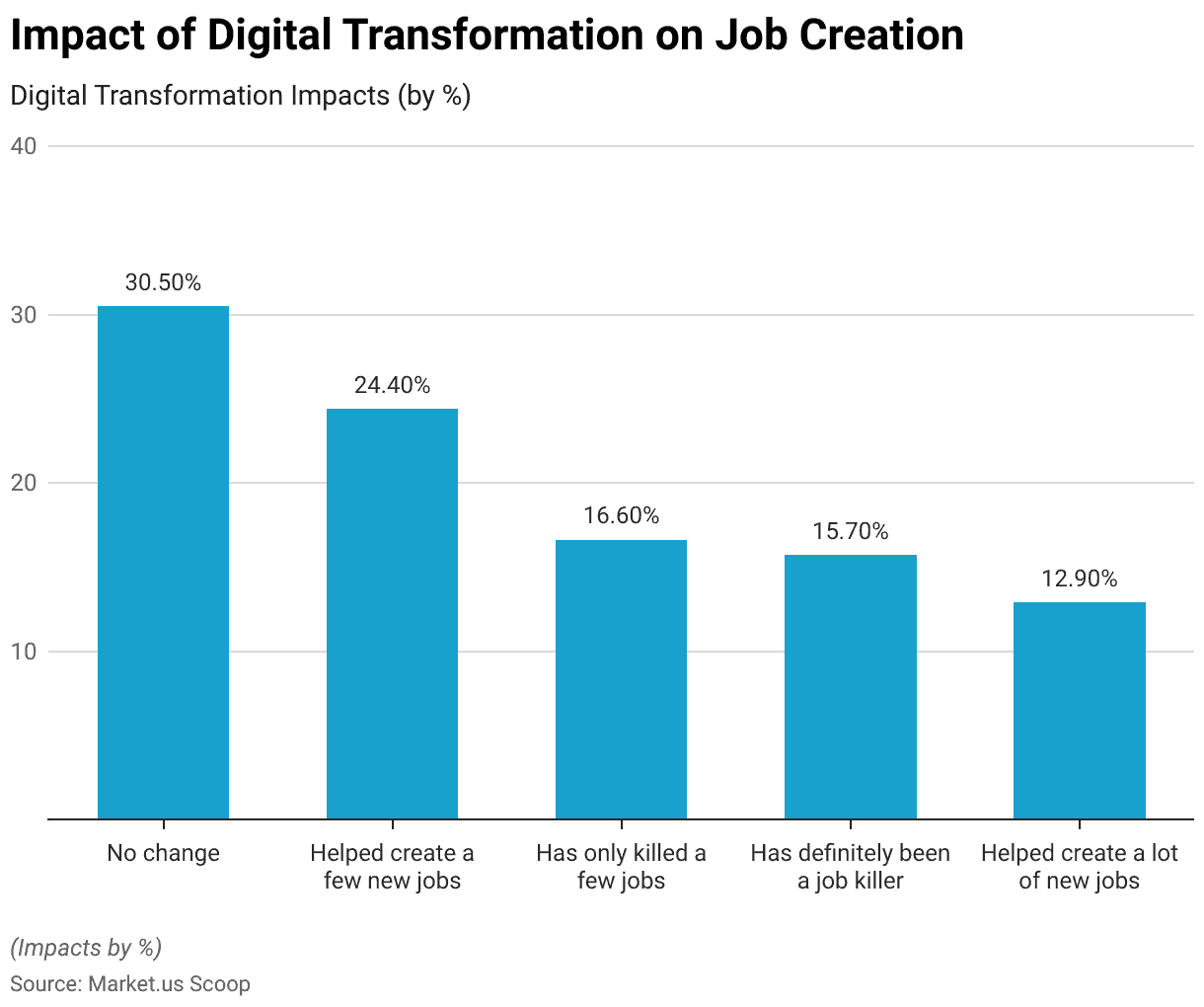
Technology Adoption Statistics
Digital transformation cannot occur without technology adoption. Slow adoption could become a problem as businesses recognize they’re slow adopters; yet many claim to feel comfortable using technology for digital transformation use – perfect conditions for transformation! Check out the data below to gain more insight.
- AI was used by 15% of businesses in 2018.
- with 31% planning to implement AI by 2019.
- Meanwhile, 76.6% of firms believe their relationship to technology and digital transformation is usually average or above average.
- IT, customer support, and marketing have excelled in technology adoption. Manufacturing, HR legal, and HR were most likely able to adapt quickly.
- As of 2020, 30% of firms were still considered lagging when it comes to adopting technology and innovating.
- Estimates suggest that as a result of COVID-19’s outbreak, firms accelerated their adoption of digital technologies for customer and supply chain interactions by 3-4 years.
- North America saw the greatest surge in digitalization, with 60% of goods and services completely or partially becoming digital.
- 72% of businesses that were among the first in their field to test digital technologies during a pandemic reported successfully responding to COVID-19.
- 25% of businesses globally have adopted large-scale cloud-based distribution technology.
- Respondents reported that their organizations responded 20-25 times more quickly than expected when making COVID-19 modifications, particularly regarding remote working. Businesses implemented digital technology faster to support remote work.
(Source: CMO 2018, Futurum 2018, Accenture, 2020, McKinsey 2020, KPMG 2020)
Market Size Digital Transformation Statistics
The Global Digital Transformation Market in 2022 is estimated at 535 billion dollars and projected to reach USD 3,375 billion in 2032.
It is projected to experience a compound annual growth rate of 20.8% due to technological advancements like Big Data Analytics, Artificial Intelligence (AI), and cloud services accelerating corporate expansion worldwide.
(Source: Market.Us)
Regional Analysis
North America will hold 42% of the market by 2022 due to the increasing use of internet connectivity and the adoption of various online payment options.
Furthermore, various initiatives are underway within North American states to hasten digital transformation processes faster – for instance, ensuring compliance with regulations designed to safeguard data.
Digital transformation is increasingly used by organizations to make their products and services available to more customers, increasing market growth in North America dramatically.
Digital transformation requires highly flexible IT support that is accessible even by smaller organizations in this region; North America boasts an advantage here due to its many manufacturing retail automotive operations within both countries as well as advanced software programs available here.
Asia Pacific is projected to experience one of the fastest compound annual compound rates over its forecast period due to a surge in foreign direct investments (FDIs) that support digital transformations and government investments into cutting-edge technologies.
According to a report issued by the United Nations Conference on Trade and Development (UNCTAD), even during COVID-19’s global pandemic surge, APAC witnessed foreign investment increase significantly – reaching USD 620 billion as of 2022!
Recent Developments
Mergers and Acquisitions:
- IBM has made several acquisitions to enhance its consulting capabilities and technological offerings, including acquiring companies like Pliant, Application Modernization Capabilities from Advanced, and StreamSets from Software AG.
- In the healthcare sector, United Health acquired LHC Group for $5.4 billion, aiming to expand its home care services for the aging population.
- Amazon expanded its healthcare footprint with a $3.9 billion acquisition of One Medical, a move that added numerous medical clinics to its network.
New Product Launches:
- Merck has been actively leveraging emerging technologies such as AI, ML, and big data. They have initiated several technology-focused programs to enhance their drug development and operational efficiency.
Funding Trends:
- Digital health funding saw a significant downturn in 2023, totaling $10.7 billion across 492 deals, marking the lowest annual total in four years.
- FinTech startups also continued to attract investments, with prominent acquisitions like CardWorks Servicing acquiring Dataline Systems and Duck Creek Technologies acquiring Imburse Payments.
Sector-specific Insights:
- The BFSI segment led the digital transformation market with the largest revenue share, driven by enhanced consumer experiences and the adoption of advanced technologies.
- In the FinTech sector, significant activity included acquisitions aiming at expanding services in North America and enhancing digital payment solutions.
Conclusion
Digital technologies streamline processes, automate tasks, and eliminate time-consuming activities to increase productivity and save organizations both time and money.
Digital transformation enables businesses to personalize interactions with customers across multiple channels for seamless experiences and leverage data insights for insight into customer preferences and behaviors – increasing customer satisfaction and loyalty while speeding innovation faster.
Furthermore, digitization allows organizations to rapidly adapt to changing market dynamics by responding quickly to customer needs in real time while setting the foundation for experimentation, iterative improvements, and the creation of new business models.
FAQ’s
Digital transformation refers to the process of using digital technologies across an organization to radically transform how it operates and provides value to customers. Digital transformation involves using technology to streamline processes, increase efficiencies, enrich customer experiences, and spur innovation.
Digital transformation is key for businesses looking to remain competitive and relevant in a constantly shifting digital environment. Digital transformation helps organizations adapt to evolving customer expectations, optimize operations, and take advantage of new opportunities presented by digital technologies.
Digital transformation may be driven by many different forces across industries, but its drivers often include customer preference shifts, disruptive technologies, market competition, regulatory requirements, or operational efficiency needs.
Digital transformation utilizes various technologies, including cloud computing, big data analytics, artificial intelligence (AI), the Internet of Things (IoT), mobile applications, and automation. These enable organizations to collect and analyze data, automate processes, and enhance connectivity.
The duration of digital transformation varies depending on the size and complexity of the organization, its existing technological infrastructure, and the scope of the transformation. Digital transformation is an ongoing journey rather than a one-time project, as technology and customer expectations continue to evolve.
Digital transformation can be challenging due to factors such as resistance to change, legacy systems, and processes, lack of digital skills, data security, and privacy concerns, and the need for significant investment in technology infrastructure and talent development. Overcoming these challenges requires strong leadership, clear vision, and effective change management strategies.
Discuss your needs with our analyst
Please share your requirements with more details so our analyst can check if they can solve your problem(s)



